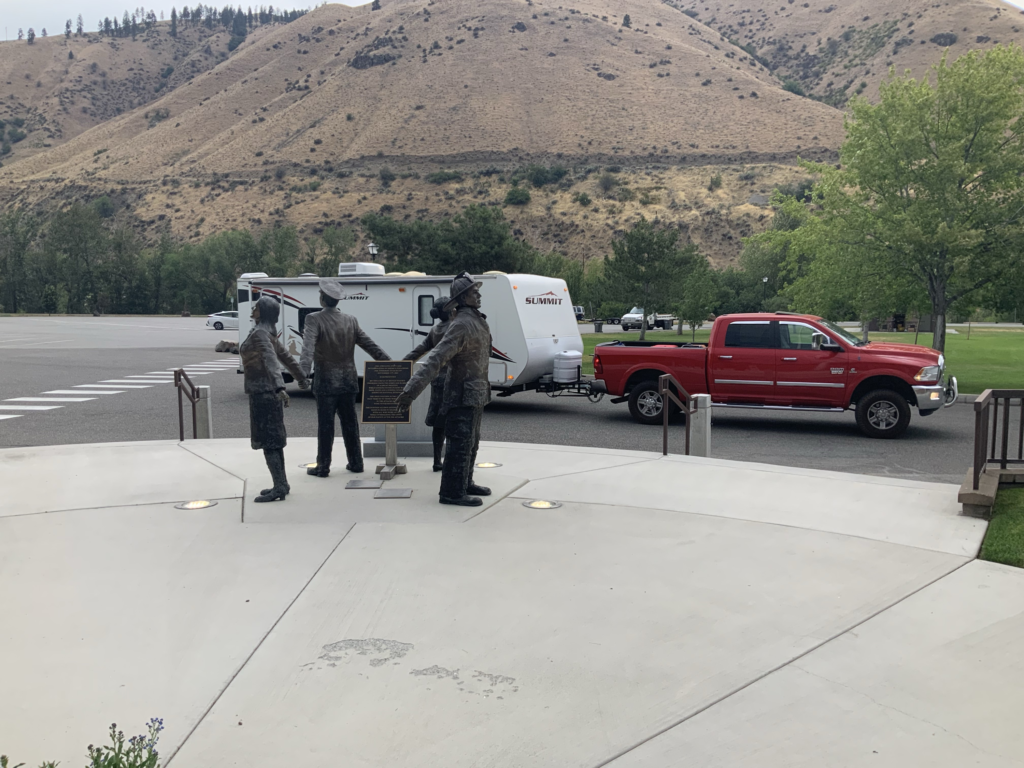IF YOU ARE READING THIS IN AN EMAIL, CLICK ON THE HYPERTEXT TITLE ABOVE TO READ THIS POST IN BIGGER PRINT
(Note: This blog entry represents a combination of writings and pictures already posted about our Cool Change II, Land Yacht Adventures 2021 through Cindy via Facebook and Rick via email. So for some of you, the following posts may be duplicative, but for others, this is the first time you are seeing them. I am repeating them here to centralize the record and share our experiences more broadly.)
Cindy’s Post
So it has been three weeks and one day since we left Coloma for our USA tour. The last time I posted we were about to leave for Cashmere and Leavenworth, Washington to float the Wenatchee River with our son Dan and his family. We ended up parking our trailer for free in a City of Cashmere park, which was also the takeout for the “play” run. I got to hop on a raft as a passenger (due to my shoulder surgery) the first day, and Rick paddled his IK with Dan in his hard shell for two days in a row. We had a ball with Leanne, Dan’s partner, and her girls Kadence and Addison. We ate mostly taco street food, we roasted marshmallows, and we played in the water. I loved watching Dan with the girls – he has such a natural parenting instinct. And it was fun to be called Gramma. I hope I can live up to the name.



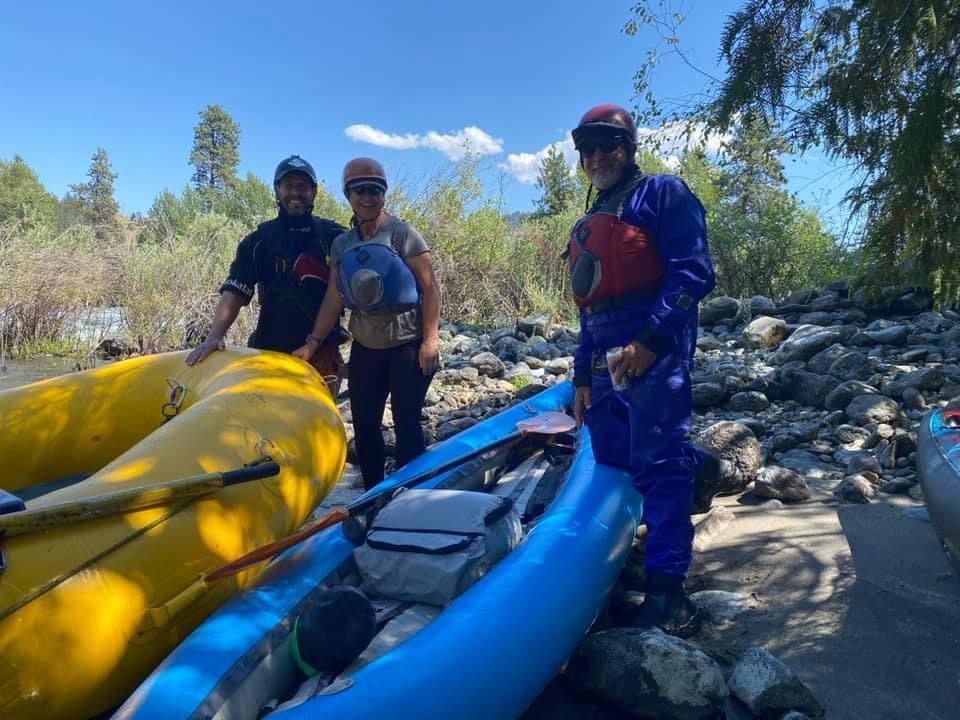
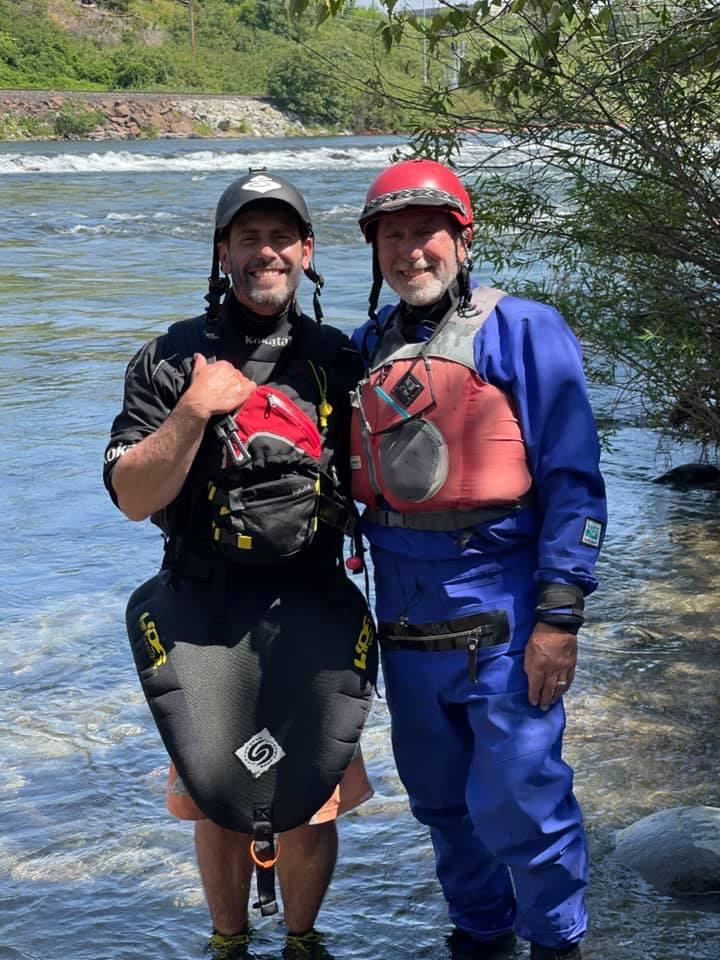
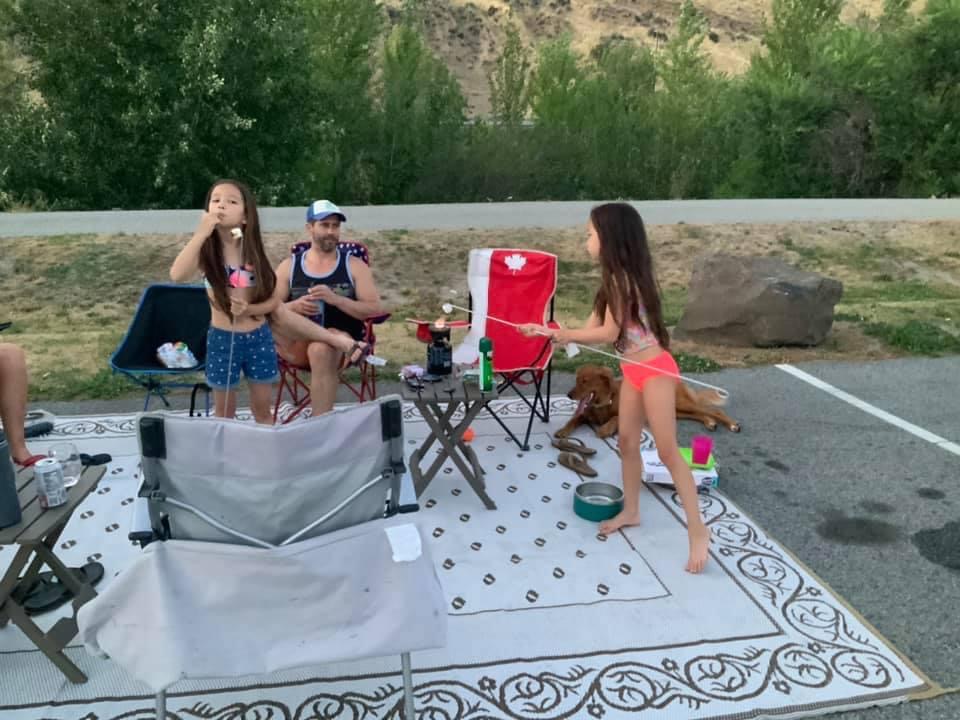

Next we headed towards Spokane to visit with a longtime river friend Laura Zulliger and her husband and two teenagers for the night. They treated us to homegrown beef, a dip in their pool and good conversation.
After that we headed to Glacier National Park. The park has breathtaking vistas, but the most satisfying part is to get off the beaten path and hike into the wilderness. Next time, maybe. This time we just took very populated trails that were the most obvious for beginners, but still challenging enough for us to get our steps in, plus some! On one hike that started out on a boardwalk, we actually counted seven separate snow fields that we had to traverse! And it was pretty much uphill for a mile and a half, but still not considered the most challenging. A fun fact: the difference between a glacier and fallen snow is that glaciers compact the snow below so much that it melts before the top layer does, and causes the whole thing to slide.

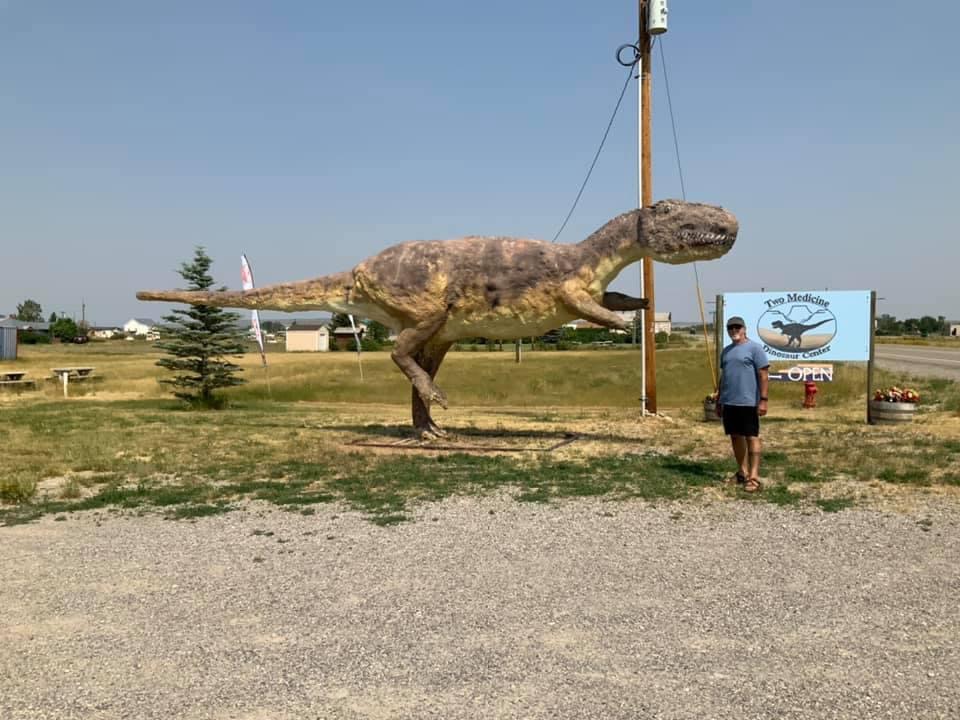


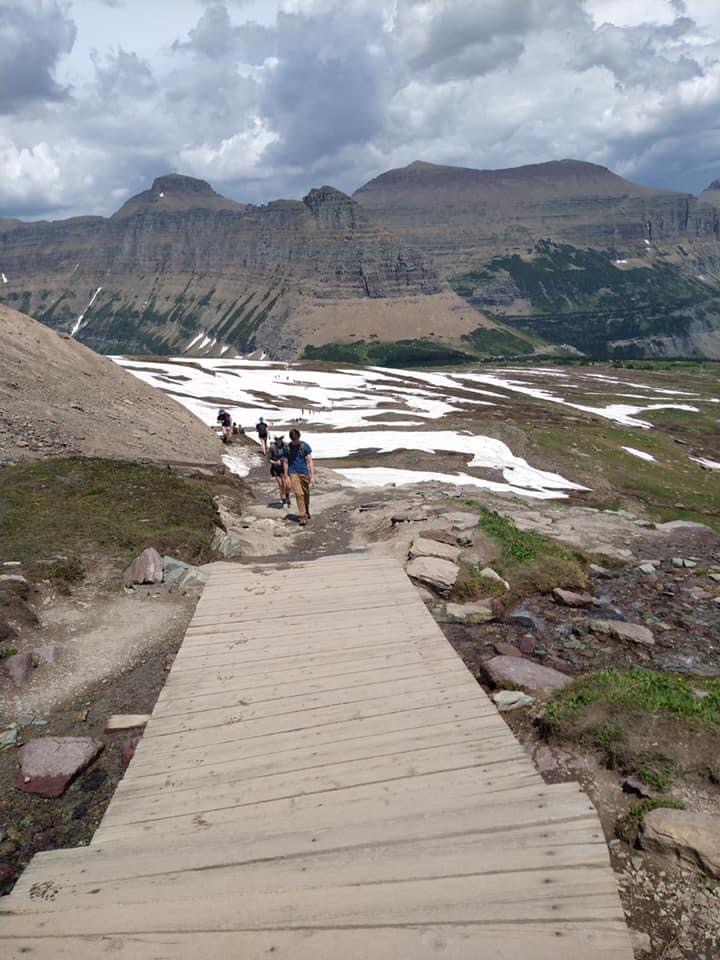


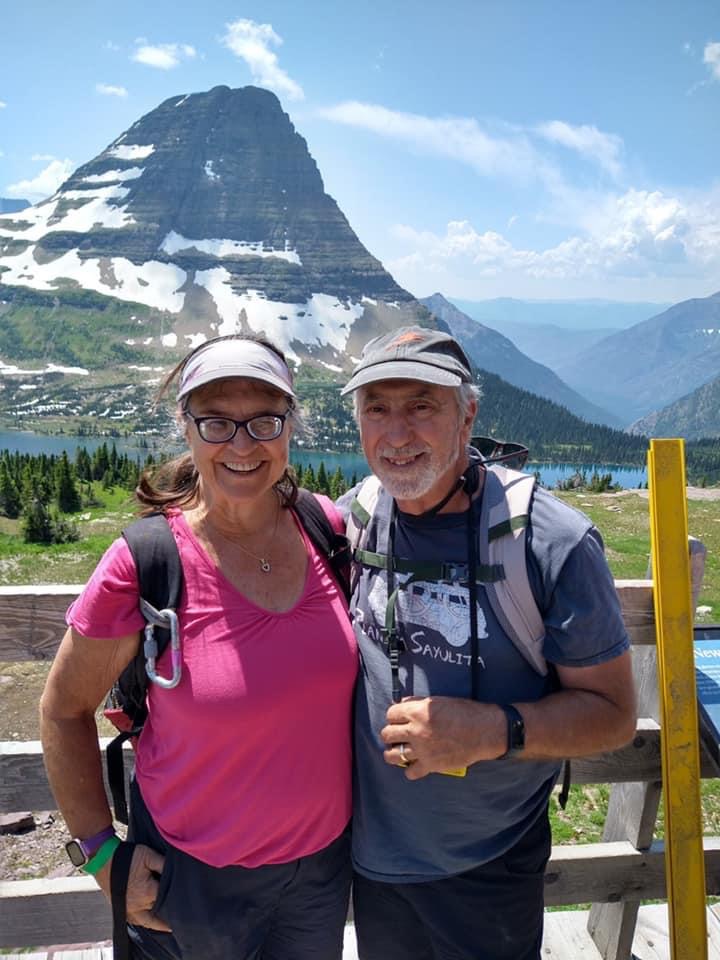
The RV park we stayed in left much to be desired, but it was nice to hook up to electricity. The Blackfeet folks who ran it were very kind and thoughtful but it was as though they just didn’t have the resources or the know-how to make the park worth staying there. At least the spots were large, the electricity worked, and the water in the showers was hot.
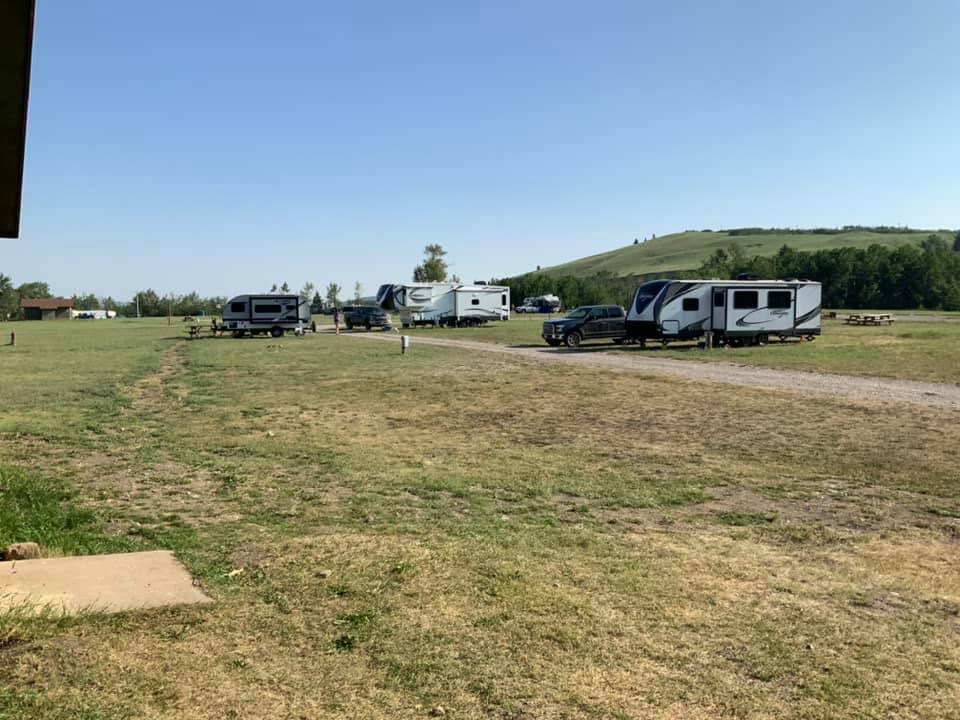
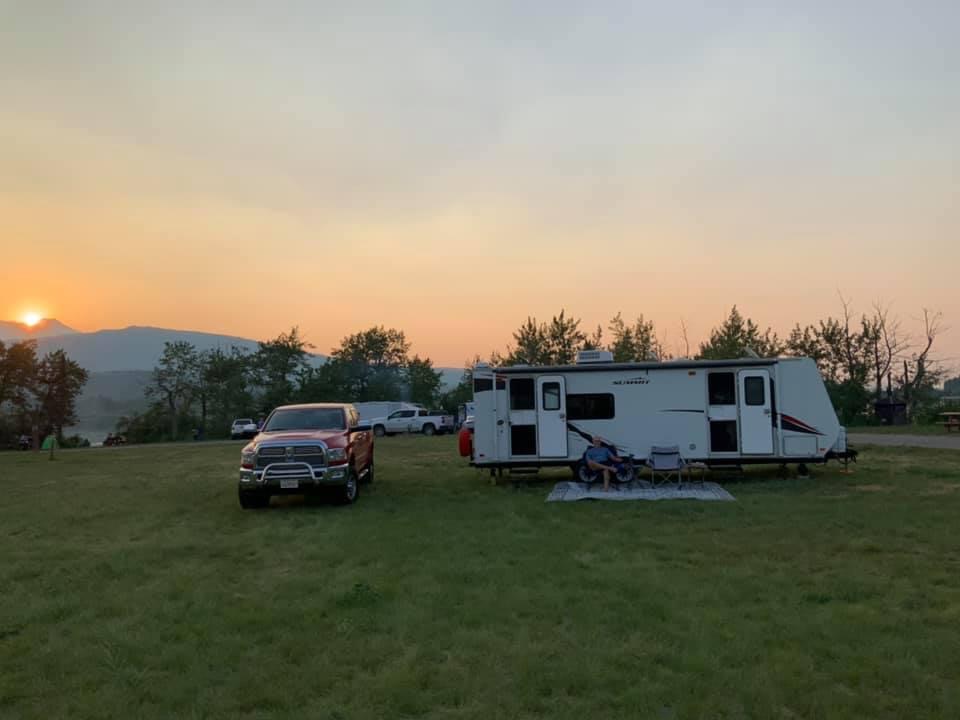
We are a little worried that water might be seeping inside a wall inside the trailer from the air conditioning water condensation, and the airbag light in our truck is misbehaving, but besides that, all is fine. We spent a few hours today in a Home Depot parking lot with a rented step ladder checking out our air conditioning unit. Tonight we are staying in one of the RV’rs favorite Walmart parking lots in Bozeman, Montana. Tomorrow, if all goes well, we will be heading for a week without internet in a campground in Yellowstone.
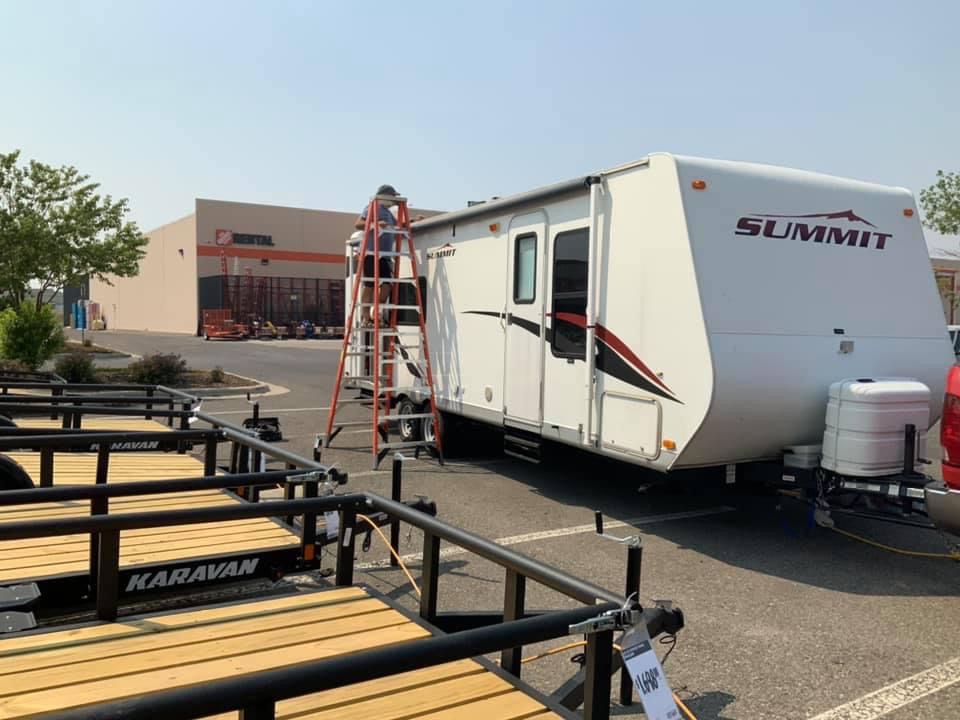
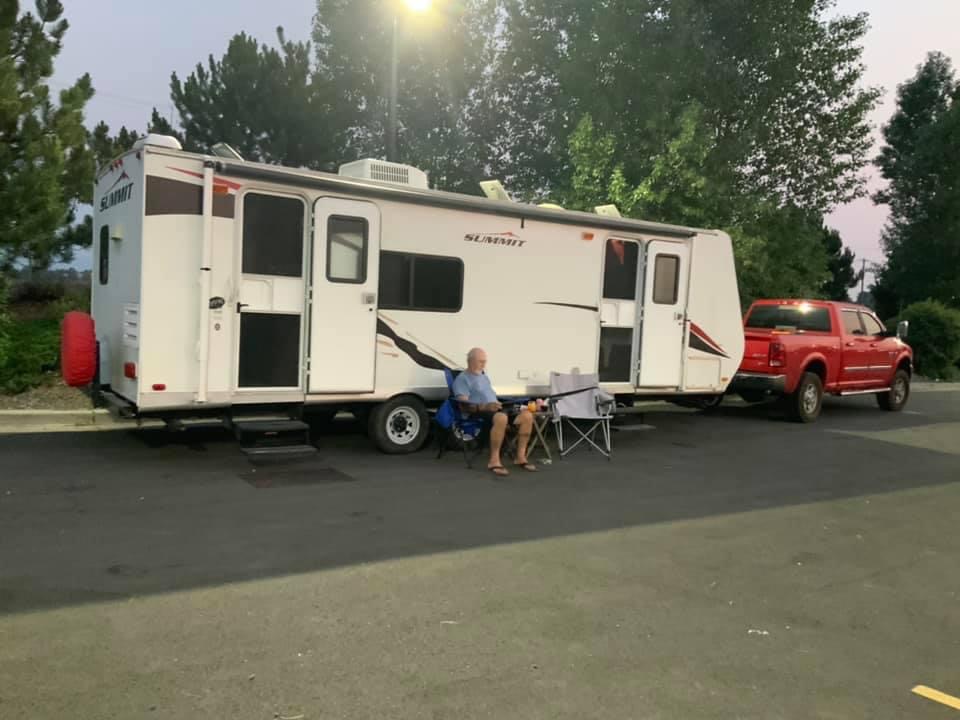

* * * * *
RICK’S UPDATE
The drive to Cashmere was about 4 hours from Gig Harbor. We got off to an early start and arrived early afternoon in Cashmere. The road over the pass was fairly windy and in many places was just one lane in either direction. There are many steep grades of up to 7%.
Our truck has a diesel braking system that is very much needed when going down a steep grade. What would normally result in a lot of braking leading to hot brakes and lots of wear is all but eliminated between the diesel brakes and the 6 speed automatic transmission. I have never driven a truck like this before so it has been a learning curve how to properly drive it but I am getting more used to it each day. Whenever we are moving with the trailer we enable the diesel brake and tow modes on the truck. With those settings on, whenever going down hill, with foot off the accelerator the motor uses its compression and automatically downshifts from overdrive into the next lower gear. If you subsequently need to use the brakes at all, the transmission again will automatically shift to the next lower gear. This is normally enough braking for the steepest of hills even when though we are being pushed along by 9,000 pounds of loaded trailer. A couple of times I have needed to manually shift down into fourth on the steepest of hills but that is rare. Any time we do apply the truck brakes, there are electrically actuated brakes on the trailer wheels that are activated in tandem with the truck brakes. This is standard on most all travel trailers. The control for the trailer brakes is from a module in the truck that can be set for varying degrees of stopping power. If set too light they do nothing, and adjusted too high they will lock up the trailer wheels any time you apply brakes in the truck! Because of the consequences it is a quick learning curve to test and set the amount of braking required.
When we arrived at the county park in Cashmere, we found they had spaces marked out to be used by RV’s, busses, and other raft company vehicles. It was not very crowded and there were no entry or parking fees. As there were no signs prohibiting it, we decided it would be ok to spend the night there. We would stay connected to the truck for an easy exit in case we got kicked out in the middle of the night!
The park is well maintained with lots of nicely kept grass areas and trees for shade. There is a boat ramp for taking out or launching rafts and in one section of the park there is a very touching 911 memorial. There are statues and monuments with plaques listing the flight numbers along with the names of all the airline passengers lost in the 911 attacks. There are also sections of the metal superstructure from one of the twin towers. Inscribed at the bottom of the title plaque of the memorial are the words “This is an place of peace, reflection and education for everyone. We must never forget.”
Before we arrived at the park, I had been texting our son Dan, who was already in the area with Leanne and the twins Kadence and Addison. He had been concerned about his Sprinter van because he had just had it serviced before this trip and the oil light was coming on intermittently at higher RPM’s. He found that the dealer had put too much oil in when they changed it out and he was pretty sure that it was the problem. He ended up having to siphon the excess oil out of the dipstick hole and that seemed to confirm his suspicions as the light stopped coming on. (Thank you University of Youtube!) I had noticed the same overfill condition on our truck when we had it serviced before we left, but the level was not as high as Dan’s, so we have not had any trouble.

Dan & family got to the park about an hour after we arrived and soon another one of Dan’s paddling buddies and his family arrived as well. Jen and Taylor and their daughter Kinley, who is about the same age as the twins, were planning to go on the river as well. They brought a nice oar raft with them that was inflated on a trailer and ready to go. Taylor told me the raft had belonged to his father who passed it on to him, and in return, Taylor bought his dad a cataraft. (A good deal for both!) So we came up with a plan where Dan and I would paddle our kayaks and Cindy and the kids would all go in the raft with Taylor, Jen and the girls. This would be the first time Cindy had been on the water since her shoulder replacement surgery 13 weeks earlier. She would not have done it if not for the fact that Taylor was a very experienced rafter and knew the river very well. I was really happy that Cindy would be able to go on the river that day!
Cindy and I brought inflatable kayaks along for this trip. Cindy bought hers just before her shoulder surgery (a zippy Aire Force model) and I purchased one second hand from our good friends Terry and Thea. The boat I bought is about 12 years old but has been kept in very good condition. It is an Aire Tributary, which is one of Aire’s lower end models, but all of Aire products are very high quality and this is a nice boat. I only had a chance to paddle it once back home on our Coloma to Greenwood class 2 run but from that experience I felt really comfortable about the boat.
The Part of the Wenatchee we were setting up to run is a class III of about 6 miles and is called “The Play Run.” We would shuttle upriver from the park to the put in and take out right at the park. The water on the Wenatchee is not dam controlled and due to the heat wave the NW had been experiencing, much of the melt had already passed by. A week earlier it was flowing at about 14,000 cfs and when we ran it on July 5th it was down to about 5,000 cfs. When the Wenatchee is running at 14k it is fairly continuous with some really big wave trains. That is the time it is most popular with the commercial rafting companies that operate on it. At 5k it was less continuous, a bit more technical and still very fun!
When we arrived at the take out, we put all our gear away and got together on the lawn to socialize. Leanne drove out to a nearby taco truck and brought back dinner for everyone. Back at the park, we had some time to get to know Taylor and Jen. Taylor works for Werner Paddle Company in Washington as a sales engineer and Jen is a school teacher.
Werner is one of the top whitewater paddle manufacturers in the nation. They make some very nice kayak paddles in many designs using composites as well as fiberglass or combinations of the two. They normally have about 30 people working the production line but since the pandemic they have been down by several employees and are behind in production. Taylor said he recently had to contact all the retail outfitting companies that they supply with their products and give them the news that there would be a limit to what each company could order this year and he let each company know what that number was. Werner is trying to avoid disappointing customers by not taking orders that they could not timely fulfill. I had the opposite experience with the company Dagger Kayaks last year when I ordered one of their boats through our local dealer. Though they had notified the owner of the store that they were behind in production due to the pandemic, they estimated that my boat would be shipped to the store in late October 2020. (This was in September 2020) The October delivery date came and went and Dagger kept changing the production schedule until my expected delivery was as far out as June 2021! Fortunately for me, there was a person who had ordered the same model boat (a Dagger Rewind) in the same colors and he had failed for over a month to come pick up the boat he had purchased. Dan, the owner of the store, then instructed the store manager Kristin to give the purchaser another call and give him a week to pick up the boat. If he did not come get it, Dan would refund the buyer’s money and sell the boat to me, which is what eventually happened. If not for that bit of luck I doubt I would have taken delivery before we left.
We met some more of Dan’s regular paddling buddies that day as well, Cody and Amara, who were planning on paddling the Tumwater run with Dan the next day. Cody and his wife Ginger are also sport pilots and fly a tandem motorized hang glider and additionally are sport paraglider’s
There was another young lady present named Eleanor who at 15 is already an accomplished class 5 kayaker, under guidance from her dad. I asked her if she had any other kids her age to paddle with and she said to her knowledge she was the only kayaker in the high school she attends in the area. So she has pretty much learned from and paddled with adults since she started kayaking. Having such an early start at kayaking and being such a solid paddler, I think she is going to do some awesome things in the world of whitewater in the future.
The next day, the plan was for Dan, Cody and Amara to do the Tumwater section of the river a little outside of the town of Leavenworth. The Tumwater is just a few miles but it is a solid class 5 whitewater run. I was planning on doing some aerial video footage of the group in several of the drops using my drone. They were planning on doing the run 2 times so I was going to use the first run to get familiar with the areas I would be filming, in and on the second run I would try to get the best footage. I have had some practice flying it to video some of the rivers back home in Coloma but this river I found to be very challenging. During the first run I was only able to capture a little bit of footage because the wind was a factor as well as learning locations of obstacles to avoid such as trees along the shore and wires crossing the narrow river.
When the group started their second run, I had changed my location to a point below the first drop rather than above it. On the first run I found it difficult to fly back upriver and land where I was located, just below the Tumwater dam. So this time I was well below the first drop and flew the drone up to meet them and then backwards towards me as I was filming them coming downriver. It was going well until they passed the location I was flying the drone from. I should have brought the drone in right then but instead I went ahead and followed them from behind into the next drop.
I started having some stability issues and I tried bringing the drone back but in the process I lost control and ran it into a tree that was beside the river about 100 yards downstream of me. The last thing I saw on the video screen was the branch of the tree I ran into and then the water at the edge of the river it was crashing down into! I was fairly certain that it hit the water but I went to look for it just in case it had somehow ended up in the rocks onshore. There is a feature in the app I use to fly it that works the same way as the find my iphone app. A user can activate a beeping alarm and flash a strobe to help locate the drone. I scrambled through the area to the exact location (the last known transmission point) and it was nowhere to be found, confirming the probability that it crashed into the water.
Dan and Cody, who had done the second run together, had figured something was wrong as they were waiting above the next drop that they knew I was going to film them on. When I did not show up they were getting concerned. Finally they saw me drive by them on the road towards the takeout so they finished the run and I explained what had happened. Though I was a bit sad at the loss of the drone, I can think of at least one friend who has lost a few drones, flying them off of his catamaran in the South Pacific. So I will get another to replace it, though this time I will just need to buy the drone as I still have all the accessory equipment. That will make it much less of an expense.
While Dan was out kayaking, Leanne and the girls were playing in a calm pool of water with a nice beach just below the takeout. We collected everyone and went to a local homemade candy store that the twins had been promised a trip to. There they used money they had made a couple weeks prior from a lemonade stand they had set up by Dan’s home. It was really fun watching them shop for their favorite treats.
We went back to the county park and Dan and I decided we had time to do one more trip on the play run. Leanne kindly offered to shuttle us to the put in and then hang out with Kadence, Addison and Cindy. Dan and I had another fun run on this section but found it had dropped another 1000 cfs from the previous day, which made it a whole different run. It was shallower in many places, lots more rocks to avoid and the holes and waves had a different character. It felt like a completely different run as rivers often do at different flows. As we were going down a rapid called Snowblind, we saw the ladies on the shoreline where they had been waiting to watch us go through this rapid. They were hollering and waving at us as we made our way down river.
They met us at the takeout and as it was still so hot, we all sat in the water there and played fetch with Leanne’s dog India. India will just not stop the game once it gets started! She never seems to tire of it.
We had a final meal together, which Dan bought this time from the same taco truck, and then we said our goodbyes as they headed for home. We stayed the night again in the county park before setting off for our next destination to spend an overnight with some rafting friends Laura and Mark and their teenagers Jasper & Althea, who live in the Spokane, Washington area.
As planned, we were on our way to make a stop in the Spokane area to visit with some long time rafting friends Mark & Laura. We last saw them in the summer of 2020 when we went on a raft trip together on the Snake River in Utah. It was a fun filled multi-day remote river trip with them, their daughter Althea and another good friend of ours from back home, Deb Halford.
Due to the pandemic, the Snake river trip was the only real get-away we had in 2020. We all felt safe doing this trip together because we had all been pretty much confined in our own homes for months and this would be an outdoor adventure with just our group, well isolated from the masses.
The area Mark and Laura live in is on the west side of Spokane (Medical Lake) on some acreage in a home that Mark built long ago in his bachelor days. It is a few miles off the main road and down another mile or so of gravel road. Mark & Laura’s driveway would have been difficult to turn around in so they made arrangements with a neighbor to let us park the rig in their drive.
The neighbors were a cheery older couple who on our arrival told us we could park in their drive, or even on their green lawn if we so desired as their son and his family do when they visit in their travel trailer. We opted to park in the drive which was just fine and we left the trailer connected to the truck so that we could get an early start in the morning when we would be headed out to Glacier National Park in Montana.
We had a short walk down the hill to Mark & Laura’s home, and while we were waiting for Mark to get home from work, the 3 of us went for a swim in their above ground pool. After the several hour drive from Cashmere, the water felt fantastic!
Mark soon arrived and joined us in the water for a while and then we all went inside and enjoyed more visit time as they were preparing a nice dinner for us to share that evening.
Though we had already met their youngest daughter Althea, we would now meet their oldest offspring, Jasper on this visit. Althea is just starting high school this year and Jasper will be going away to college in the Seattle area in September.
Jasper goes by the pronoun “They”. Though Jasper was born female, they identify as non binary. They are a very bright young person, and I think struggling to find themself in today’s world as so many of our young people are. They do not have a lot of friends in the Spokane area so they are really excited about going away to school in a more liberal minded and accepting area. They seemed to really connect with Cindy and the two of them had some great dialog over the course of the evening. Cindy had a lot to share about her first years living in San Francisco from the age of 21. Cindy who grew up in Homewood, Illinois, left the midwest in 1973, where after completing her undergraduate degree she purchased a motorcycle and traveled first east and then west all the way to San Francisco to start a new life.
Cindy shared with Jasper what it was like for her, coming of age in a climate where there was much resentment and discrimination and even violence against what was then a large gay & lesbian community in San Francisco. Also what it was like to live through and loose many close friends and community to the AIDS epidemic. She told her story of working for the Mayor’s office when Mayor Moscone along with the first openly gay Supervisor, Harvey Milk, were both assassinated by Dan White. Mr. White, a disgruntled former elected county supervisor in San Francisco, was upset that the Mayor would not reinstate him as a Supervisor after he had resigned his office in a huff. His defense team used the infamous “twinkie defense” as an explanation of what actually caused Mr White to commit the murders. Jasper and their sister Althea had heard of Harvey Milk but had not known about the details of the historical events Cindy was sharing them, and they seemed to be listening with a new appreciation for what it was like living in that time and place.
Jasper was about to undergo breast removal surgery a few days after our visit. They have been on testosterone therapy for some time, and this was the next step in Jasper’s transition. We hope it all went well and that Jasper was happy with the results and more comfortable with their body.
I am sure that Althea will really miss Jasper being in the home. They are very close and share much the same views on politics and life. Though Althea does not identify as non-binary, she “thinks” she identifies as bisexual. She is bright and reads a lot, as does Jasper. She makes a loud statement with her multi colored hair and like any teenager, her parents embarrass her easily!
We had a wonderful evening and late that night. Laura gave us a ride back up the hill to our home on wheels and we got some sleep before an early (for us) departure. Our drive to Glacier National Park would take us 6.5 hours.
* * * * *
The drive to Glacier National Park from Spokane took about 6.5 hours. Very soon after leaving Spokane the wind really picked up and in some places, it was so strong across the road that we had to slow down to 45mph. There were lots of tumbleweeds blowing across the road in our path and at times swirling plumes of dust blew in front of us, coming out of many recently plowed fields.
At Glacier we stayed outside of the park in a campground / RV resort on Blackfeet Indian reservation land. The name of the park is “Chewing Blackbones.” The reservation in this section of Montana extends to the border with Canada and to Glacier National Park, spanning 1.5 million acres.
The first small town we went through on reservation land was the town of Browning. It is a small town of about 1,000 people and it is the headquarters for the Blackfeet Indian Tribe. It is the only incorporated town on the reservation. Our first impression was that it looks very impoverished. As for businesses, there is only a small local market, a couple of gas stations and a couple of cafes. Most of the houses are very run down with the exception of a few newer homes on the edge of town. There was a large amount of litter along the main road leading out of town. The sight of all the litter strewn about seemed to signal a lack of pride in the environment these people are living in. Possibly it is a by-product of despair.
Leaving Browning, it was another 30 miles to Glacier’s east park entrance. The campground we stayed in is about 7 miles from the park. The campground is situated on a beautiful piece of land that borders lower St. Mary’s Lake. Some of the sites have full hookups and others just water and electric. We took a walk around and were disappointed at the condition of the shower and restroom facilities. One of them was completely shut down and the others were barely functional. There were holes in the walls and planks on the floor of the showers covering broken tiles. A first impression was that they did a very poor job of maintaining the campground though later we found out that the park had been vandalized during the prior winter. Many of the water pipes had burst after being inadvertently left on during a winter hard freeze.
It is a large and beautiful park but clearly the operators are struggling to get back up to speed following the vandalism, weather-caused damage and of course, the pandemic. We noticed when we first arrived that there was a no vacancy sign even though the park was only about 25% full. I think that to their credit, they were trying not to over stress the limited facilities that were still operational. We heard also that they had recently been having problems with local people from the reservation showing up and occupying sites without paying and when confronted, refusing to leave. We wondered if it had to do with locals feeling a sense of entitlement to be staying there as it is located on reservation land. Later in our stay we gained some more insight as to the local culture of the tribespeople that have lived many generations in the area.
Glacier National Park started a new online reservation system just this year. In an attempt to reduce traffic in the park, they have expanded shuttle bus services and limited the number of cars allowed inside the park.
Glacier now operates a fleet of shuttle busses that take visitors on the “Going to the Sun” road, which is an approximately 3 hour drive between the east and west entrances to the park. On the website we read that you must have a reservation to ride the bus at a pre-scheduled time, which made it seem overly complicated. In reality, we found that as long as a person had made a reservation for the day, the operators would give you an armband that served as your ticket and you could get on and off the shuttle whenever and wherever you wished all that day. Private vehicles or vehicle/trailer combinations longer than 21 ft long or 8 ft wide including mirrors are not allowed to go on the road to the sun. We could soon understand the reason for the size limitations because the road is steep, narrow, and very windy, often with a sheer cliff face on one side and a deep ravine on the other. The guard rails looked more decorative than purposeful. A young couple we met on the ride told us about an incident a couple of years ago where a person tried to pull a large trailer over the pass on this road and caused a major problem. By the time the park rangers had caught up with them, the side of their trailer had been peeled back like a sardine can from scraping against the rock face along the road. I can only imagine what it took to get them out of there!

Our first day in the park, we rode the shuttle from the park entrance at St Mary’s to the visitor center at Logan Pass. Once there, we went on a hike to Hidden Lake, which is a 1.6 mile trail to an overlook of a beautiful alpine lake. The hike is rated as “challenging” and has an elevation gain of 625 ft. When we started on the trail it was at first hard to understand the rating, as the trail was wide and clear with bridges over the obstacles and rough areas. There are also lots of boardwalks and stairs. Then, about half way to the top, we had to cross our first ice field. This proved to be the challenging part of the hike and we had to cross 7 more ice fields on the way to the overlook. We had not brought our hiking sticks and it was very slippery so we ended up borrowing a couple of snow trail marker stakes to use as hiking stick substitutes . That allowed us to get through the fields without slipping and falling.
We saw some mountain goats along the way and also some big horn sheep grazing along the slopes. As we were on our way back, the clouds started gathering and there was lightning in the distance so we were glad to arrive back down at the visitor center when we did. There were a lot of people on this trail that day and it was good to see so many families out enjoying nature.
The upper end of Glacier National Park meets up with the Canadian border and Canada’s Waterton Lakes National Park. In 1932 the Federal Governments of the US and Canada officially joined the two parks as Waterton-Glacier International Peace Park to celebrate the peace and goodwill along what is the world’s largest undefined border. Both parks have been designated Biosphere Reserves and World Heritage sites and in 2016 they were designated as the world’s first transboundary International Dark Sky Park.
The Glaciers have steadily been shrinking throughout the park. There is an ongoing USGS project started in 1997 with a goal of tracking the changes in the glaciers. Scientists have gathered historical photos from the early days of the park and chronologically follow the changes up to the present day. The Park’s current glaciers were at their peak at the end of what is called the little ice age around 1850. Then the retreat of the glaciers started with a warming trend that had little to do with human influence. But between 1991 and 2010 they found that 70% of the warming could be attributed to human influence from greenhouse gas emissions.
Our second day in the park we rode the shuttle quite a bit farther to an area called Avalanche creek. The scenery as we went up over Logan’s pass then descending west to the valley floor was breathtaking. We got off of the shuttle at Avalanche campground and walked on a short easy hike through the trees called “Trail of the Cedars.” It was only a mile long so we supplemented it by exploring the three loops through Avalanche Campground. The campground was closed so it was empty and the entrance was barricaded. We spoke with a ranger working there who told us they had originally left it open for people to park as an overflow to the parking area but that people were trashing the campsites so they decided to close it off. It is a beautiful campground with tall trees everywhere and sites that can easily accommodate 30 ft trailers and tow vehicles. (You have to come in from the west park entrance to get to that point with an RV.)


We had not had any cell or wifi access to speak of since we left Spokane. There was supposed to be wifi access at the St Mary’s visitor center at the east entrance to the park but it was offline when we were there. On our way back to the campground we happened upon a KOA that had wifi service. We just wanted to make a quick check of messages to see if there was anything we needed to know. With a little social engineering we were able to get the wifi password and get online. We checked messages, I downloaded a few Duo lingo lessons and Cindy downloaded a couple episodes of a series we have been watching so we could watch them later, back in the campground.
There was going to be a ranger talk that evening in the park discussing the Native American history of the area. We decided we would attend, and it turned out to be a very interesting presentation. Instead of a park ranger giving the talk, there was a local Native American named Johnny Running Crane.
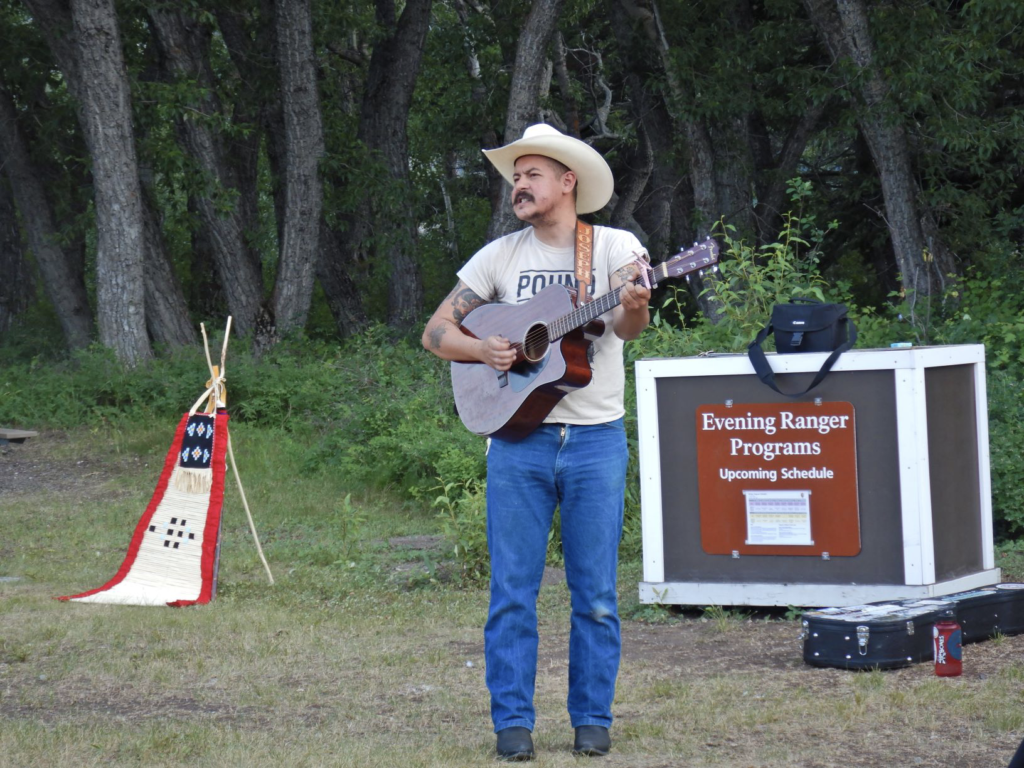
He is a musician who tells the stories of his people through a combination of his talk and original songs that he would accompany on acoustic guitar. The songs he played told some sad stories of his people. He explained that the characters and events he writes of in his songs are composites of the events and people he has experienced throughout his life. One of his songs is about a young man who dies as a result of a drunk driving accident on the road between Bowman and Heartland. He spoke of, then played another song about the phenomenon of missing and murdered Indigenous women. He told us that every year dozens of Native American women disappear from their homes, lured away by promises of employment. The women are seldom heard from again. Many are murdered and others are sold into sex slavery. He explained that many young men go missing as well. Because they are a sovereign nation, when people go missing, the tribe has little help from outside authorities to investigate the disappearances.
The song he sang was of a young man, actually his cousin, who was lured away and later found murdered. The song is written in the first person of his cousin and was about the life that this young man would never have. He urged his family to forget he was ever alive because he had missed out on the life he should have had but was denied him.
Johnny spoke of the efforts by the US government to define a Native American as a certain percentage of bloodline in order to claim their heritage and accompanying benefits. His belief is that the reason the government seeks to define this percentage is that the data can be used to deny long standing entitlements to the tribal members. This practice creates a quandary because unless the tribespeople intermarry outside of the tribe, the bloodlines become too limited. He credits his grandmother with teaching him much of his native American traditions, but only later in life did he find out that she was actually Jewish and married into the tribe. Even though she had been a part of the tribe for her entire adult life, she could not share in the benefits normally provided to them, such has government provided healthcare and tuition for higher education. Johnny referred to the government’s actions as “genocide by dilution.”
At the end of his talk and performance, he held a question and answer session and one of the questions that was asked was what can non tribal people do to help the Native Americans. His reply was that people should just take the time to look past whatever negatives they may see in a person and to try and engage them in conversation. He explained that this is the way to learn about and understand who they really are as a people.
* * * * *
After spending 3 nights in Glacier National Park we got underway to Yellowstone National Park, a place I only remembered from a visit there with family when I was 12 years old.
We had been noticing a problem whenever we ran the trailer’s air conditioning system. The weather was very hot and this caused the AC unit to emit a large volume of condensation water. This water then drains off of the roof and to the ground via the small rain gutters designed to direct the water to one of the 4 corners of the roof.
Originally at each corner of the roof there were extensions to the rain gutters whose purpose was to direct the water away from the trailer rather than just letting it run down the outside walls. Over time, these extensions were made brittle due to UV damage and they had all broken off.
Though we had purchased a replacement set of the extensions in Oregon, I did not install them then. At the time, I thought that we would be able to have them installed somewhere along the road at an RV repair center, avoiding me having to work off of a ladder to get it done. What we have actually found in our travels is that it is nearly impossible to get any service done at an RV center without waiting weeks or sometimes months for an appointment. The pandemic has resulted in a huge increase in RV sales across the country and the dealers are all too busy just getting their new units dealer-prepped after being sold.
Because of the water running off the roof and down the outside walls, we discovered another problem. Water was somehow getting to the face of the inside wall as well, coming out from under a window in the dining area. Obviously, this would not only affect us when we ran the air conditioner but also any time we encountered rain, which up to then we had not.
As we did not have a sufficient ladder with us that would allow me to safely climb to the roof, we stopped at a Home Depot and rented one, thinking that I could install the rain gutters and get a look at the roof to see what could be causing the leak. We found a quiet area in the parking lot, set up the ladder, and I climbed up to the roof. I found a spot at the edge of the roof that looked suspicious so I covered it with some silicone caulking. I took the cover off the AC unit and cleared the drain lines and removed several large abandoned wasp nests (unrelated to the problem but they had quite the community at some point).
We went on our way not optimistic that my repair attempt had accomplished anything at all. I later discovered that the leak was actually a result of water getting through the gasket at the top of the window so I used some duct tape to seal it off and that has eliminated the problem. Where would we be without duct tape? Our latest dilemma is that the rubber seal for the slide out leaks when the slide is in the open position during rain. If we are not able to park in a perfectly level position and the high side is the side with the slide out, the leak worsens. I’m sure that this is a common problem with travel trailers. I found some protectant and cleaner for the seals to help keep them from drying out or deteriorating further.

